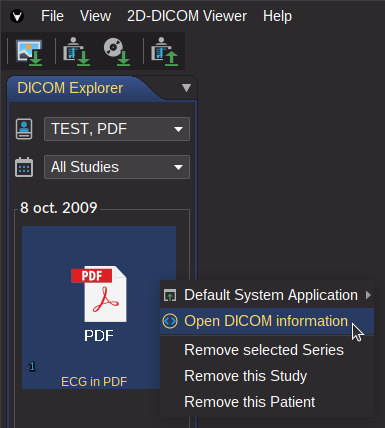AI DICOM Objects
DICOM objects generated by artificial intelligence
Artificial intelligence (AI) frameworks can produce various DICOM objects for different purposes. Here are some common DICOM object types produced by AI frameworks and how they are handled in Weasis (see the info windows below).
DICOM Secondary Capture (SC)
This type of object represents secondary images where the AI has embedded information in the image pixels. These images may include annotations, measurements, or other enhancements to the original image data.
Info
DICOM Secondary Capture can be displayed by Weasis like any other image data, see DICOM 2D Viewer.
DICOM Segmentation (SEG)
These objects represent the results of segmentation algorithms applied to medical images. Segmentation involves partitioning an image into multiple segments to simplify its representation for analysis or display. AI frameworks can produce SEG objects containing segmentations of anatomical structures, lesions, or other regions of interest.
Info
See DICOM SEG for displaying DICOM SEG objects in Weasis.
DICOM RTSTRUCT
This type of DICOM object is originally used to represent structures delineated on CT images for radiotherapy treatment planning. Some AI frameworks may produce DICOM RTSTRUCT objects (geometric shapes) instead of DICOM Segmentation (pixel-based).
Info
See DICOM RT for displaying DICOM RTSTRUCT objects in Weasis.
TotalSegmentator automatically segments over a hundred anatomical zones on CT images. When the result is saved in DICOM RTSTRUCT (since version 2), the segmentation result can be displayed directly in Weasis:
DICOM Structured Report (SR)
AI frameworks can generate structured report containing the results of their analysis. These reports typically include structured information about findings, measurements, observations, and interpretations derived from medical images or other data.
Info
See DICOM SR Viewer
DICOM Encapsulated Documents
AI frameworks may produce DICOM objects containing encapsulated documents such as PDF reports, text documents, or other non-image data related to medical imaging studies.
Info
DICOM Presentation States
Presentation states define how images should be displayed, including display parameters such as window width, window center, and image orientation. A Grayscale Softcopy Presentation State (GSPS) object is used to display annotations and graphics that overlay on a displayed image. AI frameworks might generate presentation states to specify how images should be displayed based on their analysis results or to display graphics overlays on images.
Info
See DICOM PR for displaying DICOM Presentation States in Weasis.
DICOM Enhanced Objects
Enhanced DICOM objects contain additional information. AI frameworks might produce enhanced DICOM objects to include additional annotations or other enhancements to the image data.
Info
DICOM Enhanced (e.g., reduce noise or improve visualization of anatomical structures) can be displayed by Weasis like any other image data. Some other additional information (overlay, shutter, and pixel padding) can be added to the image rendering, see 2D Viewer Display.
